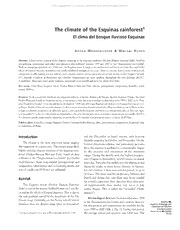
The climate of the Esquinas rainforest PDF
Preview The climate of the Esquinas rainforest
© Biologiezentrum Linz/Austria; download unter www.biologiezentrum.at The climate of the Esquinas rainforest1 El clima del bosque lluvioso Esquinas Anton WEISSENHOFER & Werner HUBER Abstract:AbriefsurveyisgivenoftheclimaticsituationoftheEsquinasrainforest(PiedrasBlancasNationalPark),basedon precipitation,temperatureandothermeteorologicaldatagatheredbetween1999and2007atthe“TropenstationLaGamba”. Withanannualprecipitationofc.5.836mm,theEsquinasforestbelongstothewettestlowlandforestsinCostaRicaandinthe wholeofCentralAmerica.Rainfallisnotevenlydistributedthroughouttheyear.ThereisadeclinefromJanuarytoMarch(al- thoughnotusuallycausingawaterdeficit),andasecond,shorterandlesspronounceddeclineinJulyand/orAugust(“veranil- lo”). Rainfall is highest in September and October. Temperatures are more uniform throughout the year (average 28.2°C). Nonetheless,theremayoccurmuchvariation,particularlyastorainfallandastotheeffectofElNiño. Key words: Costa Rica, Esquinas forest, Piedras Blancas National Park, climate, precipitation, temperature, humidity, wind, storms,ElNiño. Resumen:SedaaaconocerunabreveinvestigaciónsobrelasituaciónclimáticadelbosquelluviosoEsquinas(ParqueNacional PiedrasBlancas),basadaenlaprecipitación,temperaturayotrosdatosmeteorológicosobtenidosentre1999y2007enla“Esta- ciónTropicallaGamba“.Conunaprecipitaciónanualde5,836mm,elbosqueEsquinaspertenecealosbosqueslluviososenCos- taRicayAméricaCentral,respectivamente.Lalluvianoesconstantedurantetodoelaño.HayunadeclinacióndeEneroaMar- zo(queusualmentenoproduceundéficitdeagua),yunasegundadeclinación,masbreveynotanpronunciada,enJulioy/oAgos- to(“veranillo”).LalluviaesabundanteenSeptiembreyOctubre.Latemperaturaesuniformeatravésdelaño(promedio28,2°C). Noobstante,puedeexistirmuchavariación,enparticularenloreferidoalasprecipitacionesyalefectodeElNiño. Palabrasclave:CostaRica,bosqueEsquinas,ParqueNacionalPiedrasBlancas,clima,precipitación,temperatura,humedad,vien- to,tormentas,ElNiño. Introduction and dry (December to April) seasons, with heaviest rainfalls occurring in October and November. On the The climate is the most important factor shaping Central American isthmus, and particularly in Costa thevegetationinagivenarea.Thepresentpaperdeals Rica,thispatternismodifiedtoaconsiderabledegree brieflywiththeclimaticsituationoftheEsquinasrain- by the presence and orientation of the mountain forest (Piedras Blancas National Park), based on data ranges.Duringthemonthswiththehighestprecipita- collectedatthe“TropenstationLaGamba”(LaGamba tion(AugusttoNovember),rainfalloccursonalmost Field Station). Apart from rainfall (precipitation) and everyday.Typically,therainfallisintheafternoonand temperature,otherfactorssuchashumidity,stormsand duringthenight,inshort,heavyshowers.InSeptem- specialconditions(ElNiño)areaddressed. berandOctober,itmayevenrainforperiodsofupto 24hours.ThedriestmonthsareJanuary,Februaryand Rainfall March and during that time there may be no rainfall forseveralconsecutivedays.Anothershortdrierperi- The Esquinas forest (Piedras Blancas National od (approximately three weeks) may occur in July Park)isoneofthewettestlowlandforestsinCostaRi- and/or August. This is called the “veranillo” (“little caandinthewholeofCentralAmerica.Thisisdueto summer”). the rain gradient caused by the mountains of the Fila Meteorologicaldatahavebeenrecordedsince1998 Crucesrange.Generally,onthePacificsideofCentral attheTropenstationLaGambaandcompletedatasets Stapfia88, America there are distinct rainy (May to November) zugleichKatalogeder forprecipitationandtemperaturesareavailableforthe oberösterreichischen years1999to2007(Tab.1,Fig.1).Duringthatperiod, Landesmuseen NeueSerie80(2008): 1UpdatedandmodifiedversionofWEISSENHOFER&HUBER2001. the average annual precipitation was 5.836 mm. The 59-62 © Biologiezentrum Linz/Austria; download unter www.biologiezentrum.at Tab.1:Rainfall(mm)during1999to2007attheTropenstationLaGamba. Tropenstation 1999 2000 2001 2002 2003 2004 2005 2006 2007 Average LaGamba January 397 294 307 179 243 196 131 209 161 235 February 321 77 210 185 192 72 364 78 163 185 March 273 233 176 192 128 408 388 316 169 254 April 507 374 220 265 227 334 503 374 425 359 May 397 486 622 340 526 931 495 548 1000 594 June 566 612 498 477 497 433 572 459 512 514 July 470 473 584 643 714 508 592 540 502 558 August 742 683 499 389 554 730 588 416 766 596 September 998 1209 710 946 456 709 700 556 716 778 October 633 741 781 750 869 828 664 839 909 779 November 684 641 926 411 612 366 797 580 767 642 December 410 250 477 473 274 148 217 331 516 344 Total 6398 6072 6008 5247 5290 5658 6008 5243 6602 5836 Tab.2:ClimaticdatafortheTropenstationLaGamba. 1999 2000 2001 2002 2003 2004 2005 2006 2007 Totalannualprecipitation eachyearinmm 6398 6072 6008 5247 5290 5658 6008 5243 6602 Max.dailyprecipitation 133 152 117 135 123 224 160 150 157 inmm. (25.Sept.)(3.Sept.) (31.Oct.)(13.Nov.)(29.Oct.)(18.May) (25.Oct.) (15.Oct.)(24.May) No.ofdayswithoutrain 63 93 89 86 101 120 73 101 80 No.ofdayswithrain 302 273 276 279 264 246 292 264 285 Tab.3:Meanmonthlyminimum,maximumand much lower than in the adjacent months (July 1999: averageairtemperatures(in°C)attheTropenstation 470mmweremeasured,Aug.2002:389mm). LaGamba,1999-2007. The rainfall on the coast of the Esquinas forest, Month Mean Mean Mean measured by Ron and Trude McAllister (Casa Orqui- monthly monthly monthly minimum maximum average deas) from 1985 to 1999, and at the Ranger station in January 23.1 32.6 27.9 the Valle Bonito in the centre of the Esquinas forest February 23.3 33.0 28.4 (measured by MINAE staff in 2002 and 2003), show March 24.0 34.1 29.1 similar values (Fig. 2 and 3) to those recorded at the April 24.2 34.0 29.1 Tropenstation. May 24.2 33.3 28.8 June 23.8 32.8 28.3 Rainy days per year. Between 1999 and 2007, at July 23.7 32.5 28.1 the Tropenstation, the number of rainy days ranged August 23.7 32.5 28.1 from246and302daysperyear,thatisfrom2/3to4/5 September 23.7 32.8 28.3 ofthedaysoftheyear.Inthatperiod,theaveragenum- October 23.6 31.8 27.7 ber of rainy days was 276 per year (3/4, In 2000, over November 23.5 31.3 27.4 60% of the annual precipitation fell on just 67 days. December 23.3 31.2 27.3 There was no rain on 93 days (Tab. 2) and less than highestmonthlyaveragewasinOctober(770mm)and 10mmofrainwasrecordedon104days. September(778mm).InMay2004,224mm(thatisc. Effects of drought. During the drier period (Janu- 4% of the annual precipitation) of precipitation were ary-March),sometreesmaydroptheirleavescomplete- measuredinaday.ThedriestmonthswereJanuary(235 lyandaconsiderablequantityofleaflitteraccumulates mm),February(185mm)andMarch(254mm).Varia- ontheforestfloor.Someofthesmallerstreamsonsteep tion was highest in February, with precipitation values terraindryup,butotherspersistandformsmallpockets rangingfrom77mm(2000)to364mm(2005).Howev- er, the period between January and March cannot be ofwater.FromDecember1997toApril1998,“ElNiño” qualifiedasadryseason(nowaterdeficit)andnorisit hadagreateffectontheregionandlittlerainfelldur- comparablewithdryseasonsinotherareasofCostaRi- ingthisperiod.Manyepiphytesdied,butothersrecov- ca.Inthe“veranillo”,themonthlyprecipitationisnot eredwithinafewmonths. 60 © Biologiezentrum Linz/Austria; download unter www.biologiezentrum.at Temperature BecauseCostaRicaislocatedintheequatorialzone, theaveragetemperatureofthewarmestmonthdoesnot exceedtheaveragetemperatureofthecoolestmonthby morethan2°C.TemperaturemeasurementsatTropen- station La Gamba have been made sporadically since December 1993 and regularly since January 1999 until 2007 (Tab. 2). The average yearly temperature was 28.2°C. Themonthswiththehighestaveragetemperatures werefoundtobeAprilandMay,with29.1°C.Theab- solute maximum temperature measured was 39°C (De- cember2001).ThecoolestmonthwasDecember,with anaveragetemperatureof27.3°C(Tab.3).Anabsolute minimum (night) temperature of 20°C was reached in August1998. Diurnal temperature variation. The drier season usually shows a greater amplitude of diurnal tempera- Fig.1:Climatediagram,TropenstationLaGamba tures (based on monthly averages) than the rainy sea- (70mabovesealevel). son.Awiderange,between10°Cand13°C,wasrecord- edduringthemonthsJanuary,FebruaryandMarchand sometimesalsoinAprilandMay.Thehighestvariation Casa Orquideas (sea level) 5742 [15] during a day (up to 15°C) occurred in September and December. The least diurnal variation was around 2°C andoccurredduringlongrainyperiodsinOctoberand November. At that time there were clouds throughout thedayandnight. The seasonal variationinthemeanmonthlyaver- ageatthefieldstationwasabout2°C,andthusthedi- urnal temperature variation was greater than the sea- sonaltemperaturevariation. Humidity Fig.2:Precipitationdiagram,CasaOrquideas(sea Relative humidity is equally high throughout the level). year(averaging88.3%atthestation,minimumc.80%). It is considerably higher within the forest (97.7%) (ASHAN1996).Mistformsdailyatdawnandsometimes Valle Bonito - Ranger station (120 m) 5829 [1,3] at dusk and after heavier rainfalls. Under misty condi- tions,theairtemperatureislower. Wind and storms Generally, winds and storms are of low importance in the region. They do occur, but rarely with the force of a tornado (COEN 1983, BOZA & MENDOZA 1981). Howeverstormsmayplayadestructiverôleonthehigh peaks (e.g., Nicuesa). In May 1997, an exceptionally strongstormseverelyaffectedLaGambaanditsvicini- ty.Intheforest,mainlyonsteepridges,manylargetrees Fig.3:Precipitationdiagram,RangerStationinthe werefelledandlargegapswerecreated. ValleBonito(140mabovesealevel). 61 © Biologiezentrum Linz/Austria; download unter www.biologiezentrum.at Conclusions TheclimaticsituationintheEsquinasrainforestcan be well characterised: while the temperaturesare fairly eventhroughouttheyear,precipitationfollowsaclear- lyseasonalpattern.Nonetheless,themeteorologicalda- ta gathered at the Tropenstation from 1999 to 2007, show that there is considerable variation from year to yearandthatElNiñoyearsproducespecialeffectsthat could even threaten the survival of particular plant species(especiallyepiphyticspecies). References ASCHANG.(1996):MikroklimavonSekundär-undPrimärregen- wälderderpazifischenTieflandregionCostaRicas.Ergeb- nisseeinerMeßkampagnevomMärz/April1995.—Düssel- dorf:unpubl.ThesisonUniv.Heinrich-Heine. BOZAM.A.&R.MENDOZA(1981):CostaRicanationalparks.— Madrid:Incafo. COEN E. (1983): Climate. — In: JANZEN D.H. (ed.), Costa Rican naturalhistory.Chicago:Univ.ofChicagoPress:35-46. WEISSENHOFERA.&W.HUBER(2001):BasicGeographicalandCli- maticFeaturesoftheGolfoDulceRegion.—Stapfia78: 11-14. Addressofauthors: AntonWEISSENHOFER WernerHUBER DepartmentofPalynologyandStructuralBotany FacultyCentreofBotany UniversityVienna Rennweg14 A-1030Vienna,Austria E-mail:[email protected] [email protected] 62
